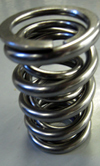Going custom for longevity
 The overhead cam Suzuki engine campaigned by 2007 NHRA Full Throttle Drag Racing Series Matt Smith in the Pro Stock Motorcycle category “pretty much controls the valves,” according to engine builder Steve Tartaglia. “Because we don’t run pushrods,
The overhead cam Suzuki engine campaigned by 2007 NHRA Full Throttle Drag Racing Series Matt Smith in the Pro Stock Motorcycle category “pretty much controls the valves,” according to engine builder Steve Tartaglia. “Because we don’t run pushrods,
I think the biggest weak link we have is in the camshafts and cam chains. It’s not anything that significantly flexes; it just varies the valve timing more than we’d like.”
The solution Tartaglia has found in his valve spring composition is going from off-the-shelf componentry to custom-built springs for his high revving engine. “To get our valve springs to live, we’ve had to buy good springs made of good material. That’s basically it. It’s all about going with the best materials and the best processes.”
Tartaglia, at the suggestion of McLaren Performance Technologies, took his business to Associated Springs – with two Michigan locations – and “told them what we were looking for. They made us a valve spring that seems to be working pretty well. I just gave them some space-related dimensions and told them how long the spring could be.”
The biggest challenge is finding room between the roof of the intake port and the bottom of the camshaft: “Everything’s got to fit in there, the bucket, the shim, the valve spring and the base. I told them what kind of pressures I was looking for, the rpm we turn, the valve lift we have and they took it from there.”
The result is an uncoated double spring made of Kobe steel. Tartaglia’s intake valve springs last about 20-25 runs; the exhaust springs will last as many as 50-60 passes down the quarter-mile dragstrip.
That is an increased life, on the intake springs, from the six-eight passes he used to get with commercial product. There is a trade-off: the current spring is a bit heavier than what he used before, weighing in at 60 grams.
“The valve on the intake side is a little bit heavier and the camshaft is more aggressive,” Tartaglia explained. “On the exhaust side the camshaft profile isn’t as aggressive. It doesn’t run as close to coil bind.”
The Suzuki engine turns about 13,500 rpm at full song. “I think some others are a bit higher, maybe closer to 14,000 but we discovered that’s where the engine is happiest, between 13,500-13,600 rpm.”
After running the same specification for three to four years, Tartaglia decided to make the change to custom during the 2008/2009 off-season. “We’d had some updates last year and before that, we ran the same specification all that time. Instead of buying an off-the-shelf spring that doesn’t last, we just decided to have the custom spring made.”
Now that he’s gone custom, Tartaglia is getting offers from other valve spring manufacturers who want his business. “We’ll talk to some of them over the winter.”
Written by Anne Proffit.